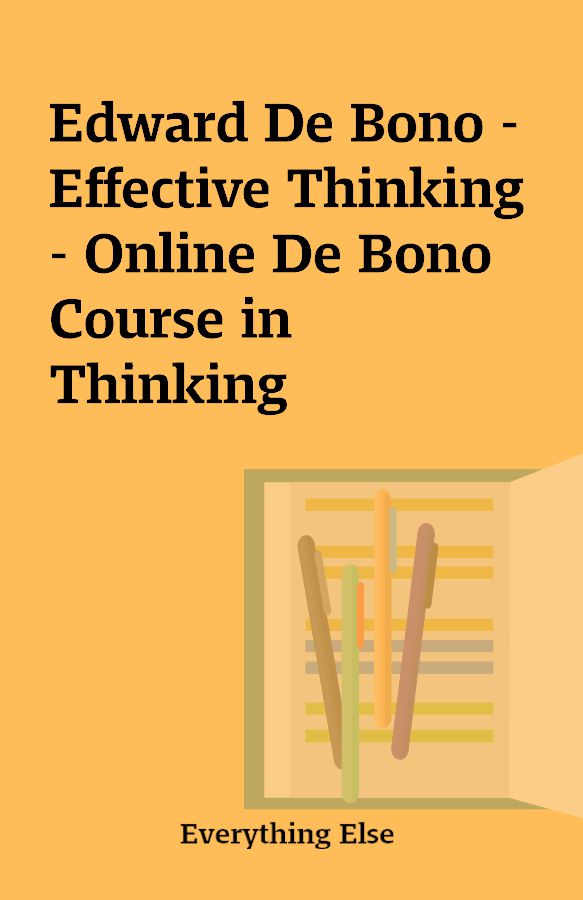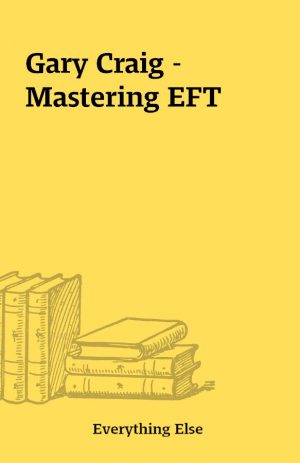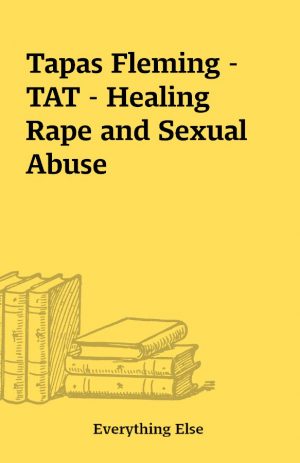Edward De Bono – Effective Thinking – Online De Bono Course in Thinking
Edward De Bono Effective Thinking Course
[ 232 DOCX , 489 PDF ]
Description
elib.tech Exclusive… sharing elsewhere will result in a bann!A General Thinking Skills CourseAt last! A distributed on-line learning course designed by Edward de Bono. The course is divided into three parts or modules and developed from the most powerful and effective CoRT Thinking Tools.This course consists of three parts and is itself part of a series on on-line courses covering Communication and Creativity which will be published shortly. These new courses should be taken in sequence.The aim of this course is to train people in thinking and to give them ‘self esteem’ in their ability to think. This leads to self confidence. This type of thinking is important to the entrepreneur and the emphasis is on this approach.THE EFFECTIVE THINKING COURSEThe course consists of three modules: 1. Basic Thinking Tools 2. Thinking Situations 3. Creativity and Lateral ThinkingThis module consists of sections on:1. Are you a thinker? This section looks at your self image as a thinker and at thinking skills2. P.M.I. Analysis of Plus, Minus and Interesting points. This is a powerful tool for considering new ideas.3. A.G.O. The examination of Aims, Goals and objectives. A.G. O. is used to clarify thinking , for example, when considering new initiatives.4. CAF. CAF involves a structured process to the Consideration of All Factors. It is often used when considering situations prior to developing ideas. CAF helps ensure that no possibilities have been overlooked.5. O.P.V. O.P.V. is an extension of CAF that gets you to consider Other People’s Views. Almost any thinking activity involves other people, at least indirectly: choices, decisions, plans, and so forth. O. P. V. tries to get the thinker inside the heads of those involved.6. FIP. FIP is a basic tool like the others. It provides a deliberate instruction to you (or to others) to focus directly on priorities (in general or at a particular moment). FIP stands for First Important Priorities.7. A.P.C. A. P. C. is another of the convenience tools that we can use with ourselves or with others in order to direct our minds to carry out some task. A.P.C. involves looking for the Alternatives, Possibilities or Choices (whichever is appropriate) in that situation.8. C. & S. ” C” stands for Consequences, ” S” stands for Sequel. Doing a ” C&S” means focusing upon and spelling out the consequences that might arise from a decision, course of action or change of any sort.This module consists of sections on:1. PLAN AND ACTION: Getting things done, making something happen, implementation, carrying something out. Thinking is involved not only in arriving at a decision but also in carrying it out. Planning is usually an essential part of getting something done.2. DECISION AND EVALUATION: Judging the value of an option. Is this worth doing? Making decisions and making choices. Why decision making can be so difficult. Decision-making as necessity and opportunity.3. PROBLEM-SOLVING AND DESIGN: Finding solutions to problems, and designing solutions to problems. In a sense any design task is also a problem-solving task because there is something to be achieved and no obvious way of achieving it.4. COPING AND ORGANISING: Coping with confusion and mess. Creating order out of chaos. Organising different elements so that the whole works- a common enough real-life situation.5. NEGOTIATION AND CONFLICT: Two party situations. Each side trying to get what it wants. This extends from win/win or mutual benefit negotiation to argument and conflict.6. COMMUNICATION AND PERSUASION: The transfer of information. The transfer of perceptions. Getting other people to see what you want them to see. Clarity of communication. Opening up perceptions in persuasion.7. EXPLORATION AND DISCUSSION: Making a map of the situation. Getting as much information as possible. Investigation, hypothesis and hypothesis testing. Explanation: what is going on? Discussion with the purpose of exploring a situation: different information and different views.8. OPPORTUNITY AND INITIATIVE: “Greenfield” thinking. Much of our thinking is reactive: we are forced to think about something. In this Section we look at initiatives: we set out to think about something because we want to. Looking for opportunities.This module consists of sections on:1. THE NEED FOR LATERAL THINKING: Realising the need to improve the quality of our thinking. Application of thinking to different areas.2. BASIC LEVEL CREATIVITY: The cure for arrogance and the deliberate search for alternatives: concepts and explorations. The mechanics of new routes.3. JUDGEMENT AND MOVEMENT: The difference between perception and processing. Patterning systems, and the concept of idiom. humour, logic and lateral thinking.4. ESCAPE: The first technique of lateral thinking.5. STEPPING STONE: The second technique.6. RANDOM JUXTAPOSITION: The third technique.7. THE TREATMENT OF IDEAS: Constraints, shaping, using and harvesting.8. FOCUS: How to define the creative thrust. The creation of idea sensitive areas for the generation of creative thinking.Thank You ALL For Making This Possible For All Of US. Edward De Bono Effective Thinking GB Contributors: Ratio FreeElite/VIP: 3 weeksPower Users (PU): 7 weeksUsers: Upgrade to PU
You must be logged in to post a review.






Reviews
There are no reviews yet.